[English] 日本語
 Yorodumi
Yorodumi- PDB-2pux: Crystal structure of murine thrombin in complex with the extracel... -
+ Open data
Open data
- Basic information
Basic information
| Entry | Database: PDB / ID: 2pux | ||||||
|---|---|---|---|---|---|---|---|
| Title | Crystal structure of murine thrombin in complex with the extracellular fragment of murine PAR3 | ||||||
 Components Components |
| ||||||
 Keywords Keywords | HYDROLASE / SERINE PROTEASE | ||||||
| Function / homology |  Function and homology information Function and homology informationproteinase-activated receptor activity / Common Pathway of Fibrin Clot Formation / Platelet Aggregation (Plug Formation) / Gamma-carboxylation of protein precursors / Transport of gamma-carboxylated protein precursors from the endoplasmic reticulum to the Golgi apparatus / Intrinsic Pathway of Fibrin Clot Formation / Removal of aminoterminal propeptides from gamma-carboxylated proteins / thrombin-activated receptor activity / Thrombin signalling through proteinase activated receptors (PARs) / Regulation of Complement cascade ...proteinase-activated receptor activity / Common Pathway of Fibrin Clot Formation / Platelet Aggregation (Plug Formation) / Gamma-carboxylation of protein precursors / Transport of gamma-carboxylated protein precursors from the endoplasmic reticulum to the Golgi apparatus / Intrinsic Pathway of Fibrin Clot Formation / Removal of aminoterminal propeptides from gamma-carboxylated proteins / thrombin-activated receptor activity / Thrombin signalling through proteinase activated receptors (PARs) / Regulation of Complement cascade / Peptide ligand-binding receptors / G alpha (q) signalling events / Cell surface interactions at the vascular wall / : / thrombospondin receptor activity / thrombin / thrombin-activated receptor signaling pathway / negative regulation of astrocyte differentiation / neutrophil-mediated killing of gram-negative bacterium / positive regulation of phospholipase C-activating G protein-coupled receptor signaling pathway / ligand-gated ion channel signaling pathway / positive regulation of collagen biosynthetic process / positive regulation of blood coagulation / regulation of cytosolic calcium ion concentration / fibrinolysis / negative regulation of proteolysis / negative regulation of cytokine production involved in inflammatory response / positive regulation of release of sequestered calcium ion into cytosol / acute-phase response / lipopolysaccharide binding / positive regulation of insulin secretion / platelet activation / positive regulation of protein localization to nucleus / positive regulation of reactive oxygen species metabolic process / blood coagulation / antimicrobial humoral immune response mediated by antimicrobial peptide / peptidase activity / regulation of cell shape / heparin binding / : / regulation of gene expression / positive regulation of cell growth / endopeptidase activity / cell surface receptor signaling pathway / positive regulation of phosphatidylinositol 3-kinase/protein kinase B signal transduction / apical plasma membrane / receptor ligand activity / G protein-coupled receptor signaling pathway / external side of plasma membrane / serine-type endopeptidase activity / positive regulation of cell population proliferation / calcium ion binding / protein-containing complex / proteolysis / extracellular space Similarity search - Function | ||||||
| Biological species |  | ||||||
| Method |  X-RAY DIFFRACTION / X-RAY DIFFRACTION /  SYNCHROTRON / SYNCHROTRON /  MOLECULAR REPLACEMENT / Resolution: 2 Å MOLECULAR REPLACEMENT / Resolution: 2 Å | ||||||
 Authors Authors | Bah, A. / Chen, Z. / Bush-Pelc, L.A. / Mathews, F.S. / Di Cera, E. | ||||||
 Citation Citation |  Journal: Proc.Natl.Acad.Sci.Usa / Year: 2007 Journal: Proc.Natl.Acad.Sci.Usa / Year: 2007Title: Crystal structures of murine thrombin in complex with the extracellular fragments of murine protease-activated receptors PAR3 and PAR4. Authors: Bah, A. / Chen, Z. / Bush-Pelc, L.A. / Mathews, F.S. / Di Cera, E. #1:  Journal: J.Biol.Chem. / Year: 2004 Journal: J.Biol.Chem. / Year: 2004Title: Molecular Dissection of Na+ Binding to Thrombin. Authors: Pineda, A.O. / Carrell, C.J. / Bush, L.A. / Prasad, S. / Caccia, S. / Chen, Z. / Mathews, F.S. / Di Cera, E. #2:  Journal: J.Biol.Chem. / Year: 2007 Journal: J.Biol.Chem. / Year: 2007Title: Structural Basis of Na+ Activation mimicry in murine. Authors: Marino, F. / Chen, Z. / Ergenekan, C.E. / Bush, L.A. / Mathews, F.S. / Di Cera, E. | ||||||
| History |
|
- Structure visualization
Structure visualization
| Structure viewer | Molecule:  Molmil Molmil Jmol/JSmol Jmol/JSmol |
|---|
- Downloads & links
Downloads & links
- Download
Download
| PDBx/mmCIF format |  2pux.cif.gz 2pux.cif.gz | 85.4 KB | Display |  PDBx/mmCIF format PDBx/mmCIF format |
|---|---|---|---|---|
| PDB format |  pdb2pux.ent.gz pdb2pux.ent.gz | 62.9 KB | Display |  PDB format PDB format |
| PDBx/mmJSON format |  2pux.json.gz 2pux.json.gz | Tree view |  PDBx/mmJSON format PDBx/mmJSON format | |
| Others |  Other downloads Other downloads |
-Validation report
| Summary document |  2pux_validation.pdf.gz 2pux_validation.pdf.gz | 464.6 KB | Display |  wwPDB validaton report wwPDB validaton report |
|---|---|---|---|---|
| Full document |  2pux_full_validation.pdf.gz 2pux_full_validation.pdf.gz | 471.7 KB | Display | |
| Data in XML |  2pux_validation.xml.gz 2pux_validation.xml.gz | 18.1 KB | Display | |
| Data in CIF |  2pux_validation.cif.gz 2pux_validation.cif.gz | 26.3 KB | Display | |
| Arichive directory |  https://data.pdbj.org/pub/pdb/validation_reports/pu/2pux https://data.pdbj.org/pub/pdb/validation_reports/pu/2pux ftp://data.pdbj.org/pub/pdb/validation_reports/pu/2pux ftp://data.pdbj.org/pub/pdb/validation_reports/pu/2pux | HTTPS FTP |
-Related structure data
| Related structure data | 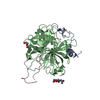 2pv9C 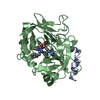 1shhS S: Starting model for refinement C: citing same article ( |
|---|---|
| Similar structure data |
- Links
Links
- Assembly
Assembly
| Deposited unit | 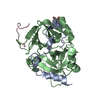
| ||||||||
|---|---|---|---|---|---|---|---|---|---|
| 1 |
| ||||||||
| Unit cell |
| ||||||||
| Details | The biological assembly is a monomer. |
- Components
Components
| #1: Protein/peptide | Mass: 5105.731 Da / Num. of mol.: 1 Source method: isolated from a genetically manipulated source Source: (gene. exp.)   |
|---|---|
| #2: Protein | Mass: 29952.625 Da / Num. of mol.: 1 Source method: isolated from a genetically manipulated source Source: (gene. exp.)   |
| #3: Protein/peptide | Mass: 1568.636 Da / Num. of mol.: 1 / Source method: obtained synthetically / Details: MIDWEST Biotech Inc. / References: UniProt: O08675 |
| #4: Sugar | ChemComp-NAG / |
| #5: Water | ChemComp-HOH / |
| Has protein modification | Y |
-Experimental details
-Experiment
| Experiment | Method:  X-RAY DIFFRACTION / Number of used crystals: 1 X-RAY DIFFRACTION / Number of used crystals: 1 |
|---|
- Sample preparation
Sample preparation
| Crystal | Density Matthews: 2.86 Å3/Da / Density % sol: 56.99 % |
|---|---|
| Crystal grow | Temperature: 295 K / Method: vapor diffusion, hanging drop / pH: 7.5 Details: 20% PEG 10000, 100 mM HEPES, pH 7.5, VAPOR DIFFUSION, HANGING DROP, temperature 295K |
-Data collection
| Diffraction | Mean temperature: 100 K |
|---|---|
| Diffraction source | Source:  SYNCHROTRON / Site: SYNCHROTRON / Site:  APS APS  / Beamline: 14-BM-C / Wavelength: 0.9 Å / Beamline: 14-BM-C / Wavelength: 0.9 Å |
| Detector | Type: ADSC QUANTUM 315 / Detector: CCD / Date: Apr 6, 2007 |
| Radiation | Protocol: SINGLE WAVELENGTH / Monochromatic (M) / Laue (L): M / Scattering type: x-ray |
| Radiation wavelength | Wavelength: 0.9 Å / Relative weight: 1 |
| Reflection | Resolution: 2→40 Å / Num. all: 28405 / Num. obs: 27610 / % possible obs: 97.2 % / Observed criterion σ(F): -1 / Observed criterion σ(I): -1 / Redundancy: 3.5 % / Biso Wilson estimate: 5.5 Å2 / Rmerge(I) obs: 0.1 / Net I/σ(I): 10.6 |
| Reflection shell | Resolution: 2→2.07 Å / Redundancy: 2.8 % / Rmerge(I) obs: 0.306 / Mean I/σ(I) obs: 2.9 / Num. unique all: 2506 / % possible all: 88.6 |
- Processing
Processing
| Software |
| ||||||||||||||||||||||||||||||||||||
|---|---|---|---|---|---|---|---|---|---|---|---|---|---|---|---|---|---|---|---|---|---|---|---|---|---|---|---|---|---|---|---|---|---|---|---|---|---|
| Refinement | Method to determine structure:  MOLECULAR REPLACEMENT MOLECULAR REPLACEMENTStarting model: PDB entry 1SHH Resolution: 2→27.08 Å / Rfactor Rfree error: 0.006 / Data cutoff high absF: 187825.98 / Data cutoff low absF: 0 / Isotropic thermal model: RESTRAINED / Cross valid method: THROUGHOUT / σ(F): 0 / Stereochemistry target values: Engh & Huber
| ||||||||||||||||||||||||||||||||||||
| Displacement parameters | Biso mean: 21.9 Å2 | ||||||||||||||||||||||||||||||||||||
| Refine analyze |
| ||||||||||||||||||||||||||||||||||||
| Refinement step | Cycle: LAST / Resolution: 2→27.08 Å
| ||||||||||||||||||||||||||||||||||||
| Refine LS restraints |
| ||||||||||||||||||||||||||||||||||||
| LS refinement shell | Resolution: 2→2.13 Å / Rfactor Rfree error: 0.022 / Total num. of bins used: 6
|
 Movie
Movie Controller
Controller



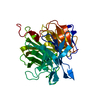
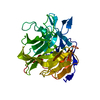
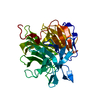
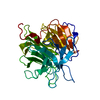
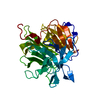
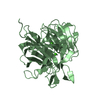
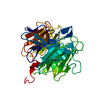

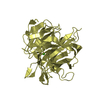
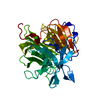
 PDBj
PDBj


















